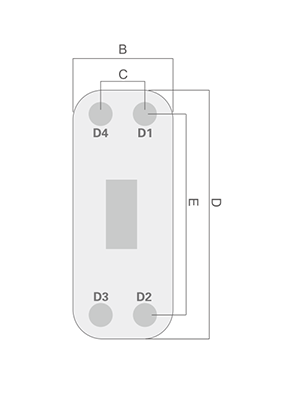· Product Introduction

· Model
ZL18 |
B(mm) 95 | C(mm) 50 | D(mm) 210 | E(mm) 165 | Thickness ( mm ) 7+3.1N |
Max flowrate ( m3/h ) 8 |
Weight ( Kg ) 0.7+0.06N Design pressure ( Mpa) 1 |
We may modify and upgrade the parameters listed in the drawings and parameter tables without prior notice. The performance parameters and dimensional drawings are subject to order confirmation.
Brazed heat exchangers can be effectively utilized in drinking water treatment processes to ensure efficient heat transfer, which is crucial for various applications such as water disinfection, cooling, and heating. Here are some key points regarding their use in drinking water treatment:
High Thermal Efficiency: Brazed heat exchangers offer a large surface area for heat transfer within a compact space, which can rapidly heat or cool the water, making them suitable for quick temperature adjustments required in treatment processes.
Corrosion Resistance: Since drinking water treatment often involves chemicals and can be corrosive, brazed heat exchangers made from materials like stainless steel can resist corrosion, ensuring a long service life.
Compact Design: The compactness of brazed plate heat exchangers allows for space-saving installation in water treatment facilities, which can be advantageous in areas with limited space.
Easy Maintenance: Brazed heat exchangers are generally easy to clean and maintain, which is important in drinking water treatment to prevent biofouling and ensure the quality of treated water.
Customizable: They can be customized to meet specific requirements of a drinking water treatment system, such as different flow rates and temperature ranges.
Energy Saving: Due to their high efficiency, brazed heat exchangers can contribute to energy savings in the operation of water treatment plants.
Safety and Reliability: Some brazed heat exchangers are designed with double wall plates for additional safety, which can be critical in applications involving drinking water.
Sustainability: The use of brazed heat exchangers can lead to a reduction in energy consumption and carbon emissions, contributing to more sustainable water treatment practices.
Versatility: They can be used in various stages of water treatment, from initial heating for disinfection processes to final cooling before distribution.
Certifications and Standards: High-quality brazed heat exchangers for drinking water treatment are manufactured to meet stringent industry standards and certifications, ensuring safety and reliability



















